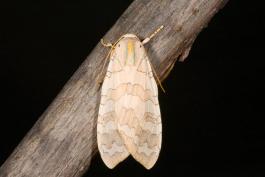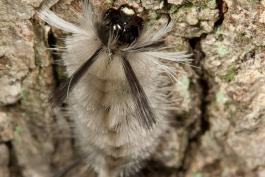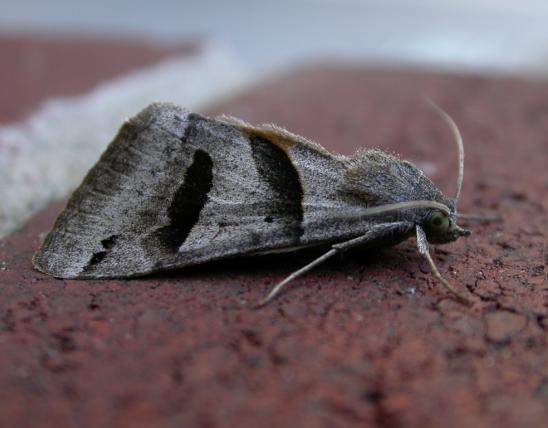
The forewings of adult banded tussock moths are pale yellow-tan or cream-colored with a distinctive checkered pattern: 4 wavering, slightly darker crossbands that are outlined by a darker color; these crossbands are composed of irregular, roughly square or rectangular blocks (kind of like tiles in a mosaic). The top of the thorax has a wide, lengthwise pale orange stripe down the middle with two thinner turquoise stripes on each side of it.
The caterpillar’s body is mostly concealed with dense, feathery hair. So-called pencils of much longer hair protrude from the thorax and rear-most segments. Hair color varies from gray to pale yellowish green, with darker shading on the thorax. The tufts running down the middle of the back are darker or blackish; the hair pencils are black and white.
Many types of caterpillars have stinging hairs or hairs that can cause a rash. Some people are more sensitive than others. If you are unsure about an identification, or about your sensitivity to possible skin-irritating toxins, you should not touch any fuzzy caterpillars with bare skin.
Learn more about this and other tiger and lichen moths (subfamily Arctiinae) on their group page.
Similar species: Adults are basically identical to the sycamore tussock moth (or Harris’ tussock moth, H. harrisii). Specialists dissect and inspect the genitals in order to separate the two species as adults. Its larval food plant is the American sycamore, skeletonizing the leaves. The caterpillars have pale whitish or yellowish hairs, and white and orangish tufts.
The name “tussock moth” is confusing, because although several types of tiger moths (in subfamily Arctiinae) are called tussock moths, there is another subfamily (in the same family) called the “true” tussock moths. Both groups have caterpillars with tussocks: clumps or “pencils” of longer hairs that protrude amid the shorter ones. The so-called true tussock moths, in subfamily Lymantriinae, used to be in their own family (just as tiger and lichen moths did), but now the groups are joined in the new family Erebidae. Both groups share the “tussock” name because both can have caterpillars with the clumps of protruding, longer hairs.
Wingspan: 1½–2 inches.
Statewide.
Habitat and Conservation
These moths and their caterpillars are usually found near wooded areas, where their larval host plants — a variety of deciduous trees — are most numerous. You may also see the adults at lights at night.
Food
Caterpillars eat the foliage of numerous trees and shrubs, including hickories, oaks, ashes, elms, walnuts, willows, birches, alders, hazels, poplars, tulip trees, grapes, and hackberries.
Status
Abundant resident found in all areas of the state.
Life Cycle
Double-brooded, with adults flying early May through August. Male and female adults are identically colored and patterned. Caterpillars are conspicuous from midsummer until the frosts of October. This species overwinters in gray, feltlike cocoons spun from the caterpillar’s hairs.
Human Connections
The caterpillars of the banded tussock moth and its relatives have received a lot of attention on social media about the itchy rashes that can occur when people touch their hairs. Keep in mind that the hairs (of this species) are not venomous, and the caterpillars are not aggressive; the hairs exist as a defense against predators such as birds, salamanders, and toads.
The caterpillar’s hairs are like tiny fiberglass fibers that embed easily in mucous tissues, such as a bird or salamander’s mouth. Young children, with their tender skin, also happen to be the most likely to discover these caterpillars and play with them. (It’s hard to resist touching such soft-looking creatures!) Fortunately, the rash — if one occurs — usually goes away after some hours or a few days. Some people, however, are hypersensitive or allergic. If the discomfort is long-lasting or severe, seek medical attention. In general, don’t touch any furry or bristly caterpillars you’re unfamiliar with.
The species name, tessellaris, refers to the mosaic-like look of the wing markings. The pattern of small, squares resemble the tessellated pattern created by small, square, flat stones.
Ecosystem Connections
The caterpillar’s hairs serve as a defense against predators. A bird, for example, that attempts to chomp one of these insects will find its mouth full of tiny hairs and abruptly lets go of the caterpillar, which can survive its brush with death and survive to maturity. The bird learns not to touch insects that resemble the tussock caterpillar. This helps explain why these tussock moths seem so easy to spot: they often rest out in the open, right on top of a leaf. Like a porcupine, they are protected by their hairs.
The adult moth’s rubbery body and sluggish habits when it visits flowers indicate that it, too, is protected: it accumulates toxic alkaloids from the plants it eats as a caterpillar, and would-be predators learn not to eat moths that look like them.

































